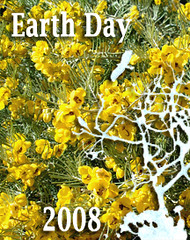With Earth Day a mere seven days away, it seemed fitting to devote a post to a date that many consider the birth of a global environmental movement (1970) and that helped usher in the concept of ecotourism.
What’s ecotourism? A few years ago, I interviewed Klaus Toepfer, then executive to the United Nations Environment Programme (UNEP), who succinctly defined ecotourism as tourism that “promotes the conservation of earth’s biodiversity.” He said that ecotourism was a unique niche because it required increased cooperation among industry, government, local populations, and tourists to ensure sustainability.
While it’s not covered as much today as it was then, ecotourism continues to grow at a rate of 20 to 25 percent annually, especially in countries like Nepal, Madagascar, and Kenya. In 2003, more than 43 million Americans considered themselves ecotourists. Today, as many as 1 in 3 would qualify.
Interestingly enough, most ecotourism is not passive. Some, like those offered by Thrill Seekers Unlimited blend in rock climbing, sand surfing, kayaking, hovercraft racing, and other extreme sports — activities that founder Rich Hopkins recognized as acceptable because people in their 20s to 40s grew up on skateboarding.
Think Globally.
Beyond thinking about ecotourism, Earth Day provides an opportunity to act on a global scale. This year, it is estimated that as many as 500 million people in 175 countries will celebrate Earth Day on April 22.
A few notable events include the free Green Apple Festival in ten cities across the United States; the Green Schools programs across America; and hundreds of other events listed all over the world, from Tokoyo, Japan, to Togo, West Africa.
Act Locally.
In Las Vegas, the fifth annual Summerlin Earthfaire, the largest Earth Day celebration in southern Nevada, runs from 10 a.m. to 4 p.m. on Saturday, April 19. It features an acoustic performance by Anna Nalick at noon.
In Reno, Econet hosts the largest celebration in northern Nevada at Reno Idlewild Park from 10 a.m. to 5 p.m. on Sunday, April 20. It includes several bands, ranging from bluegrass to reggae, performing on a solar powered stage.
Make It Daily.
Earth Day doesn’t have to be confined to a single day. In Las Vegas, the Springs Preserve is one of the city’s first major cultural attractions developed around the environment. Located three miles off the Strip, the site used to be home to palatial artesian springs that nourished the valley’s fragile ecosystem.
Although the springs dried up in 1962, 180 acres of land were preserved after the area was listed on the National Register of Historic Places. Today, the Springs Preserve has been developed into an indoor and outdoor recreational and educational site, with live concerts, artistic and eco-friendly exhibits, several play areas for children, eight acres of indigenous botanical gardens, and 25 acres of recreated desert wetlands.
Every building at the site was developed to maximize green design, including reclaimed timber, recycled building materials, on-site waste water reclamation, and solar power that provides 70 percent of all the facility’s power needs. Eventually, the Springs Preserve will also be home to the Nevada State Museum.

What’s ecotourism? A few years ago, I interviewed Klaus Toepfer, then executive to the United Nations Environment Programme (UNEP), who succinctly defined ecotourism as tourism that “promotes the conservation of earth’s biodiversity.” He said that ecotourism was a unique niche because it required increased cooperation among industry, government, local populations, and tourists to ensure sustainability.
While it’s not covered as much today as it was then, ecotourism continues to grow at a rate of 20 to 25 percent annually, especially in countries like Nepal, Madagascar, and Kenya. In 2003, more than 43 million Americans considered themselves ecotourists. Today, as many as 1 in 3 would qualify.
Interestingly enough, most ecotourism is not passive. Some, like those offered by Thrill Seekers Unlimited blend in rock climbing, sand surfing, kayaking, hovercraft racing, and other extreme sports — activities that founder Rich Hopkins recognized as acceptable because people in their 20s to 40s grew up on skateboarding.
Think Globally.
Beyond thinking about ecotourism, Earth Day provides an opportunity to act on a global scale. This year, it is estimated that as many as 500 million people in 175 countries will celebrate Earth Day on April 22.
A few notable events include the free Green Apple Festival in ten cities across the United States; the Green Schools programs across America; and hundreds of other events listed all over the world, from Tokoyo, Japan, to Togo, West Africa.
Act Locally.
In Las Vegas, the fifth annual Summerlin Earthfaire, the largest Earth Day celebration in southern Nevada, runs from 10 a.m. to 4 p.m. on Saturday, April 19. It features an acoustic performance by Anna Nalick at noon.
In Reno, Econet hosts the largest celebration in northern Nevada at Reno Idlewild Park from 10 a.m. to 5 p.m. on Sunday, April 20. It includes several bands, ranging from bluegrass to reggae, performing on a solar powered stage.
Make It Daily.
Earth Day doesn’t have to be confined to a single day. In Las Vegas, the Springs Preserve is one of the city’s first major cultural attractions developed around the environment. Located three miles off the Strip, the site used to be home to palatial artesian springs that nourished the valley’s fragile ecosystem.
Although the springs dried up in 1962, 180 acres of land were preserved after the area was listed on the National Register of Historic Places. Today, the Springs Preserve has been developed into an indoor and outdoor recreational and educational site, with live concerts, artistic and eco-friendly exhibits, several play areas for children, eight acres of indigenous botanical gardens, and 25 acres of recreated desert wetlands.
Every building at the site was developed to maximize green design, including reclaimed timber, recycled building materials, on-site waste water reclamation, and solar power that provides 70 percent of all the facility’s power needs. Eventually, the Springs Preserve will also be home to the Nevada State Museum.





















